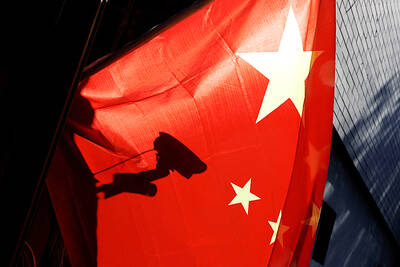Radioactive dust from Japan’s Fukushima Dai-ichi nuclear power plant could come close to Taiwan tomorrow, but radiation levels will remain “very low” and be of no risk to human health, the Atomic Energy Council said yesterday.
In its presentation, the council said it had used weather information provided by the Central Weather Bureau (CWB) from yesterday until Friday to estimate the impact of the radioactive dust on Taiwan.
One of the wind forecast models showed that the radioactive dust would approach the nation between tomorrow and Friday, it said.
“On Friday, the dust will come within 200km of the nation’s northeast coast, which will be the closest it gets,” the council said.
For Thursday, the council forecast that the maximum impact of the radioactive dust on the nation would be 0.0223 microsieverts per hour, which remained lower than the natural background value of 0.1 microsieverts per hour, it said.
The amount of radiation in the dust does not pose a health risk because it would take the human body 1,000 hours of being battered by the cloud of fallout to absorb the same radiation as a single chest X-ray, the council said.
The Government Information Office yesterday also said that radioactive dust would only come within about 200km of Taiwan at its closest over the next few days.
The council said calculations for the maximum impact of radiation fallout from Fukushima Dai-ichi were based on specific criteria — radiation levels at the plant must reach 78.4 microsieverts per hour, the emission of radioactive dusts must be continuous and the dust must also be blown directly toward Taiwan.
Meanwhile, in a markedly different assessment, Academia Sinica said the radioactive dust could arrive on the nation’s east coast today, albeit in a highly diluted form.
Liu Shaw-chen (劉紹臣), director of Academia Sinica’s Research Center for Environmental Change, said radiation within 20km of the plant had dropped to an average of 1 to 2 microsieverts per hour on Sunday.
“If the average radiation level of the dust is 1.5 microsieverts, it would potentially be diluted 100 times to 0.015 microsierverts [by the time it reached Taiwan],” Liu said.
Liu said radioactive dust would be carried to Taiwan via the northeast monsoon, which could bring rain to mountainous areas along the east coast. Radiation levels in the rain could be between 10 and 100 times higher than 0.015 microsieverts, he said.
Residents in these areas are advised to carry umbrellas and raincoats to avoid contact with radioactive fallout, he said.
So far, no abnormal levels of radiation have been detected in sea areas around northern Taiwan since the council began working with the Coast Guard Administration on March 18 to send two vessels out daily to check radiation levels. The ships have traveled as far as 630km away from the Port of Keelung.
ADDITIONAL REPORTING BY CNA

A magnitude 7.0 earthquake struck off Yilan at 11:05pm yesterday, the Central Weather Administration (CWA) said. The epicenter was located at sea, about 32.3km east of Yilan County Hall, at a depth of 72.8km, CWA data showed There were no immediate reports of damage. The intensity of the quake, which gauges the actual effect of a seismic event, measured 4 in Yilan County area on Taiwan’s seven-tier intensity scale, the data showed. It measured 4 in other parts of eastern, northern and central Taiwan as well as Tainan, and 3 in Kaohsiung and Pingtung County, and 2 in Lienchiang and Penghu counties and 1

A car bomb killed a senior Russian general in southern Moscow yesterday morning, the latest high-profile army figure to be blown up in a blast that came just hours after Russian and Ukrainian delegates held separate talks in Miami on a plan to end the war. Kyiv has not commented on the incident, but Russian investigators said they were probing whether the blast was “linked” to “Ukrainian special forces.” The attack was similar to other assassinations of generals and pro-war figures that have either been claimed, or are widely believed to have been orchestrated, by Ukraine. Russian Lieutenant General Fanil Sarvarov, 56, head

FOREIGN INTERFERENCE: Beijing would likely intensify public opinion warfare in next year’s local elections to prevent Lai from getting re-elected, the ‘Yomiuri Shimbun’ said Internal documents from a Chinese artificial intelligence (AI) company indicated that China has been using the technology to intervene in foreign elections, including propaganda targeting Taiwan’s local elections next year and presidential elections in 2028, a Japanese newspaper reported yesterday. The Institute of National Security of Vanderbilt University obtained nearly 400 pages of documents from GoLaxy, a company with ties to the Chinese government, and found evidence that it had apparently deployed sophisticated, AI-driven propaganda campaigns in Hong Kong and Taiwan to shape public opinion, the Yomiuri Shimbun reported. GoLaxy provides insights, situation analysis and public opinion-shaping technology by conducting network surveillance

‘POLITICAL GAME’: DPP lawmakers said the motion would not meet the legislative threshold needed, and accused the KMT and the TPP of trivializing the Constitution The Legislative Yuan yesterday approved a motion to initiate impeachment proceedings against President William Lai (賴清德), saying he had undermined Taiwan’s constitutional order and democracy. The motion was approved 61-50 by lawmakers from the main opposition Chinese Nationalist Party (KMT) and the smaller Taiwan People’s Party (TPP), who together hold a legislative majority. Under the motion, a roll call vote for impeachment would be held on May 19 next year, after various hearings are held and Lai is given the chance to defend himself. The move came after Lai on Monday last week did not promulgate an amendment passed by the legislature that